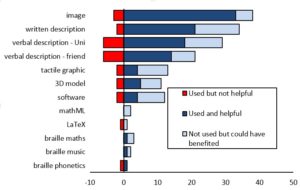
“Improving vision impaired student’s access to graphics in higher education” aimed to investigate the level and type of access that vision impaired students gain to graphic components of their study materials in higher education in Australia, to uncover any barriers to access and inclusion, and to offer strategies and resources to enable improved access to graphics for blind and vision impaired students. The project consisted of three major stages:
- Data-gathering: What access do vision impaired students currently have to graphics in higher education? What are the barriers to access? The questions were explored through a national online survey of 72 vision impaired students in higher education, along with 41 semi-structured interviews with students, their disability advisors, academics and accessible formats producers.
- Pilot studies: Working closely with vision impaired students and associated staff to trial processes and technologies over three semesters in 2015 and 2016.
- Synthesis: All study participants were invited to a full day workshop at which they developed and refined a set of model principles for improving vision impaired students’ access to graphics in higher education.
Publications
- Butler, M., Holloway, L., Marriott, K. & Goncu, C. (2017). “Understanding the graphical challenges faced by vision-impaired students in Australian universities”, Higher Education Research & Development, May 2016 – presents the results of stages 1 and 2 and provides an analysis of the underlying issues
- Holloway, L., Butler, M. & Marriott, K. (2016) “Something to Hold On To: Tactile Access to Graphics in Higher Education“, 6th General Assembly of the International Council on English Braille (ICEB), Baltimore USA.
- Holloway, L. (2017) “New and under-used strategies for accessible graphics in higher education“, webinar hosted by the Australian Disability Clearinghouse on Education and Training (ADCET)
- Holloway, L. & Lewis, D. (2018). “Preparing for Higher Education: Readiness of Vision Impaired Students for Access to Materials”, Journal of the South Pacific Educators in Vision Impairment, 11(1), 12-25.
This project was conducted in partnership by Monash University and Deakin University, with support provided by the Australian Government Office for Learning and Teaching. The views expressed in the project reports do not necessarily reflect the views of the Australian Government Office for Learning and Teaching.